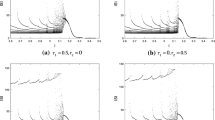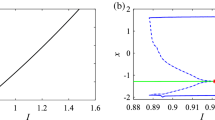Abstract
In this paper, based on the classical HR neuron model, a double time-delay flux neuron model with magnetron memristor is proposed in this paper. The stability, the existence of Hopf bifurcation, direction of bifurcation and bifurcation cycle solution of the model are studied using Routh Hurwitz judgment method and central manifold theorem. As a result, we prove that there exists a bifurcation periodic solution in the specific time-delay range of the model, and the change law of spike discharge behavior induced by increasing double time-delay is clarified, which is helpful to explain the abnormal discharge behavior of brain or nerve center caused by electromagnetic radiation. The time-series diagram and phase diagram of the model under different time lag are obtained by numerical simulation with MATLAB software. The simulation result shows that under appropriate conditions, the time-delay is less than a critical value, and the system is asymptotically stable. When the time-delay exceeds the critical value, Hopf bifurcation occurs at the equilibrium point of the system.





Similar content being viewed by others
References
Y. Qiong, Dynamic analysis of several kinds of neuron models.Lanzhou Jiaotong University (2018)
J.L. Hindmarsh, R.M. Rose, A model of the nerve impulse using two first order differential equations. Nature 296(5853), 162–164 (1982)
A.L. Hodgkin, A.F. Huxley, A quantitative description of membrane current and its application to conduction and excitation in nerve. J. Physiol. 117, 500 (1952)
A. Moujahid, A. d’Anjou, F.J. Torrealdea et al., Efficient synchronization of structurally adaptive coupled Hindmarsh–Rose neurons. Chaos Solitons Fractals 44(11), 929–933 (2011)
Z. Wang, S.A. Campbell, Phase models and clustering in networks of oscillators with delayed coupling. IFAC PapersOnLine 48(12), 105–110 (2015)
A.C.J. Luo, S. Xing, Multiple bifurcation trees of period-1 motions to chaos in a periodically forced, time-delayed, hardening Duffing oscillator. Chaos Solitons Fractals 89, 405–434 (2016)
J. Junyi, Hopf bifurcation analysis of FHN and HR neural systems with time-delay. Yunnan Normal University (2015)
Bi. Dianjie, S. Yuntao, Stability and Hopf bifurcation of a class of two neuron delayed neural networks. J. Zaozhuang Univ. 31(05), 72–77 (2014)
M. Xiaochen, H. Haiyan, Stability and bifurcation of four neuron delay networks. Mech. Q. 30(01), 1–7 (2009)
L. Ying, Stability analysis of positive equilibrium of HR neuron model with single delay. Gansu Sci. Technol. 46(01), 73–75 (2017)
A. Koutsou, G. Bugmann, C. Christodoulou, On learning time delays between the spikes from different input neurons in a biophysical model of a pyramidal neuron. Biosystems 136, 80–89 (2015)
G. Chun-Biao, P. Matjaz, W. Qing-Yun, Delay-aided stochastic multiresonances on scale free FitzHugh–Nagumo neuronal networks. Chin. Phys. B 19(4), 040508 (2010)
M. Lv, C. Wang, G. Ren et al., Model of electrical activity in a neuron under magnetic flow effect. Nonlinear Dyn. 85(3), 1479–1490 (2016)
W. Fuqiang, W. Chunni, X. Ying, M. Jun, Model of electrical activity in cardiac tissue under electromagnetic induction. Sci. Rep. 6(1), 1–2 (2016)
Y. Wang, J. Ma, Y. Xu, F. Wu, P. Zhou, The electrical activity of neurons subject to electromagnetic induction and gaussian white noise. Int. J. Bifurc. Chaos 27(2), 1750030 (2017)
W. Lixiang, Z. Jiangang, N. Mengran, Z. Meijiao, Stability and Hopf bifurcation of flux neuron model with time-delay. J. Shandong Univ. (Science Edition) 56(05), 12–22 (2021)
Y. Huanhuan, A. Xinlei, L. Zhengyu, W. Wenjing, Hopf bifurcation analysis of flux neuron model with time-delay. J. Jilin Univ. (Science Edition) 57(05), 1111–1121 (2019)
Y. Meichen, H. Fang H, Regulation of external current stimulation on Hindmarsh-Rose neuron system considering magnetic flux, in Proceedings of the 32nd China control and decision making conference, vol. 5, pp. 1069–1075 (2020). https://doi.org/10.26914/c.cnkihy.2020.047641
Y. Wu, Discharge mode analysis and circuit implementation of Morris Lecar neuron model based on memristor. Tianjin Polytech Univ. (2021). https://doi.org/10.27357/d.cnki.gtgyu.2021.000308
W. Hongmei, A. Xinlei, Q. Shuai, Z. Wei, Bifurcation analysis and synchronous control of e-HR neuron model. J. Shandong Univ. (Science Edition) 55(09), 10–18 (2020)
H. Lin, C. Wang, Q. Hong, Y. Sun, A multi-stable memristor and its application in a neural network. IEEE Trans. Circuits Syst. II Express Briefs 67(12), 3472–3476 (2020)
H. Lin, C. Wang, W. Yao, Y. Tan, Chaotic dynamics in a neural network with different types of external stimuli. Commun. Nonlinear Sci. Numer. Simul. 90, 105390 (2020)
H. Lin, C. Wang, Q. Deng, Xu. Cong, Z. Deng, C. Zhou, Review on chaotic dynamics of memristive neuron and neural network. Nonlinear Dyn. 106(1), 959–973 (2021)
L. Bingzheng, P. Jianhua, Nonlinear dynamics (Higher Education Press, Beijing, 2004)
R. Shigui, W. Junjie, On the zeros of transcendental functions with applications to stability of delay differential equations with two delays. Dyn. Contin. Discrete Impuls. Syst. Ser. B Appl. Algorithms 10(6), 863–874 (2003)
B. Hassard, Y.H. Wan, Bifurcation formulae derived from center manifold theory. J. Math. Anal. Appl. 63(1), 297–312 (1978)
Acknowledgements
The work was partially supported by the National Natural Science Youth Fund of China (No. 12001425), and the Natural Science Basic Research Plan in Shaanxi Province of China (No. 2020JM-569).
Author information
Authors and Affiliations
Corresponding author
Rights and permissions
Springer Nature or its licensor holds exclusive rights to this article under a publishing agreement with the author(s) or other rightsholder(s); author self-archiving of the accepted manuscript version of this article is solely governed by the terms of such publishing agreement and applicable law.
About this article
Cite this article
Feng, X., Liu, X., Sun, C. et al. Stability and Hopf bifurcation solutions of flux neuron model with double time delays. Eur. Phys. J. Spec. Top. 231, 2993–3003 (2022). https://doi.org/10.1140/epjs/s11734-022-00637-z
Received:
Accepted:
Published:
Issue Date:
DOI: https://doi.org/10.1140/epjs/s11734-022-00637-z




